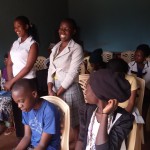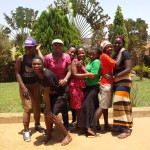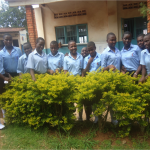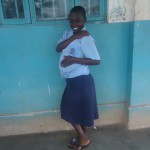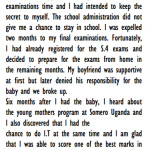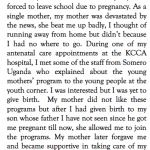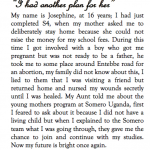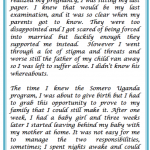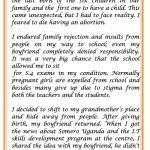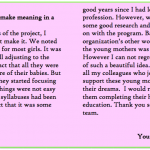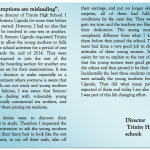Young mothers pilot project took place in Jan 2013 - Dec 2014. Currently the organization seeks funds for continuation of the program.
Incentives for project implementation
Uganda has one of the highest rates of adolescent pregnancy in Sub-Saharan Africa. 25 percent of girls get pregnant before the age of 19. Factors for that are: “first sexual encounter at a tender, for the girl, forced child marriage, coerced first sexual intercourse, family situations for the adolescent girls and limited access to sexuality education and reproductive health services, etc. The drop in teenage pregnancy rate is more marked amongst the rural (45.4%), those with no education (37%) and the poorest in terms of wealth quintiles (25.8%).” (1.)
Being a young mother brings a lot of problems with it: First, some of the girls have not yet developed a maternal body, which results to high numbers of maternal death and childbirth-related complications in adolescents. The medical problems are “obstructed labour, eclampsia, fistula, low birth weight, stillbirths, and neonatal death.” Therefore also their babies have a higher morbidity and mortality rate than with an older mother.
In addition the pregnant adolescents also face a lot of social stigmas. The social stigma and the stress affect the pregnant girl and also their unborn child. Often, this is the reason for pregnant adolescents to have an abortion. About 15 to 23 percent of girls between 15 and 24 years in Uganda have had an abortion. In Uganda it is illegal; so it is carried out under unsafe conditions, which is connected with high risk for the health and the life of the pregnant girl. The social stigmas get worse if the girl did not complete her education yet. If a girl gets pregnant she drops out of school directly and after giving birth, often they are not able to reintegrate again for completing their education. As a result of that they struggle a lot to find employment. Therefore they face financial difficulties and exploitative work. The government of Uganda has policies on adolescent pregnancy. Their aim is to prevent unplanned pregnancies of young girls, “especially prevention of forced child marriages and coerced sex, integrating sexuality education into school curriculum, girl child education and empowerment programmes, etc.” (2.)
A number of interventions are in place to cater for young mothers in the area; however there are no interventions to cater for the needs of young mothers to complete school after getting pregnant and dropping out of normal schools.
About the project
The project was designed to benefit the vulnerable young mothers of Kawempe division Kampala district. The beneficiaries of the project were young mothers between 16 and 24 years within Kawempe division whose future was at stake especially by the fact that they no longer had the hope of completing a major education level. They had lost hope in continuing with their education due to pregnancy and after being forced out of school, others had been denied a chance to continue with their education by the parents or the unfriendly schooling environment which does not cater for their responsibilities.
Majority were forced into marriage by parents as a result of getting pregnancy. These beneficiaries were identified and referred by different actors including the Somero peer educators 60.3%-, Kawempe health center 30% where the girls visited for anti-natal services and other partners.
The Home Based Schooling pilot project started in January 2013. In the beginning, the beneficiaries’ lessons were held in the community in one of the project beneficiaries’ home which they found suitable and comfortable. The organization’s hired teachers could find the beneficiaries at this home. However the project lost some of the beneficiaries before a home was secured and yet others dropped out because they were not comfortable with the home where the lessons were carried out.
With the support of Stifting 10% a library was set at the Somero center where the beneficiaries met for discussions with or without a teacher. Some lessons also started being conducted at the center. With time the center become the most convenient place for the young mothers to have all lessons. This also attracted students from other schools who brought in and shared knowledge earned from their teachers. This boosted Somero’s program called “Education boaster meetings” which are discussions.
In the last half of the project, the beneficiaries sat for a regional exam ahead of registration for the national exams. With funding from Somero Germany www.somero.eV, the beneficiaries registered for their national exams. In the last two months the beneficiaries joined Trinity High school to get familiar with the schools setting ahead of their exams and later joined a boarding session of Kawempe Royal College where they sat for their final exams.
The program was designed to run for half a day without holidays to be able to cover as much as possible just like in the normal school setting while providing time for the beneficiaries to attend to family responsibilities.
1.Population Secretariat Ministry of Finance, Planning and Economic Development: The State of Uganda Population report 2013, Population and social Transformation: Adressing the needs of special interest Groups, 2013
2. Wallace, Ashley: Adolescent Pregnancy and Policy Responses in Uganda, in: www.africaportal.org backgrounder No. 14 November 2011


